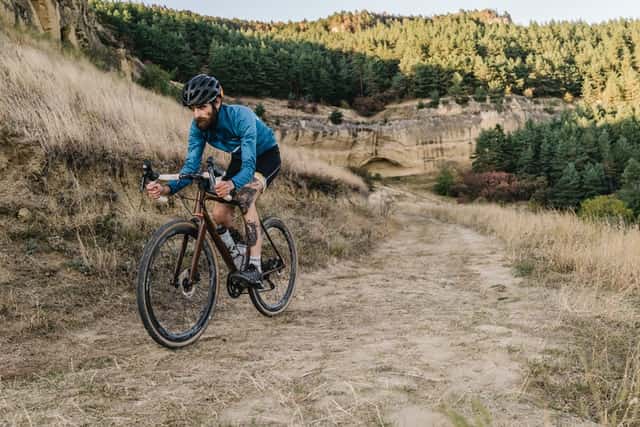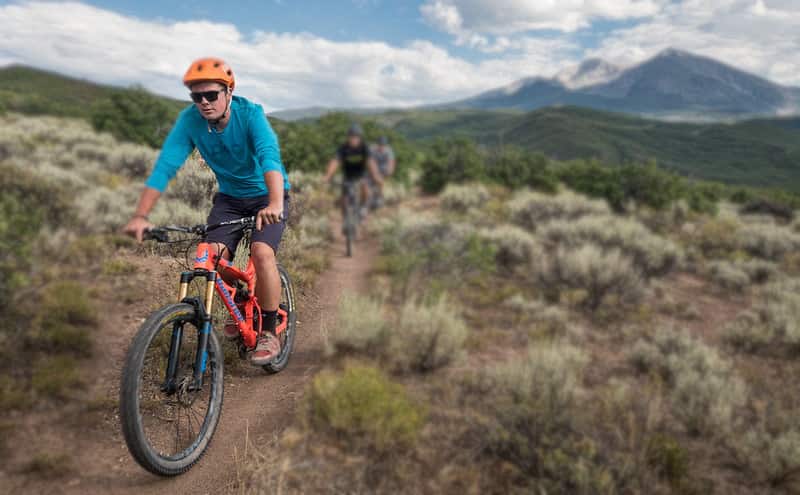You’re looking to buy a bike, and one thing that you know for certain is that you want some off-road capabilities. You already know that a mountain bike has off-road credibility, but perhaps you’ve heard about the increasingly popular gravel bikes, pitched as a versatile compromise between the road bike and MTB.
So the question becomes: which should you buy, a gravel bike or a mountain bike?
The answer is that it depends on the type of riding you expect to do. Gravel bikes are great for riding paved terrain along with flat, relatively stable trails with light inclines and minor technical features.
MTBs take over from there, excelling at climbing steep grades, fighting over obstacles and unpredictable ground, and tanking drops and frame rattling hits.
There is a point in the middle where they overlap, and can both perform well, but at either extreme — on pavement for gravel bikes, and on punishing single tracks for MTBS — one handily outdoes the other.
But, before examining their differences in detail, let’s make sure your needs align with what these bikes offer.
Gravel Bikes vs Mountain Bike: Which is The Right Bike For You?
Cyclists take up the hobby for a variety of reasons. Some are looking for a fun way to exercise, and others want a healthy and affordable way to get around, and still others are interested in competing professionally.
Both styles of bike in question can meet these needs, but which will be better depends on your specific situation.
For instance, riding for fitness has a much lower impact on the terrain suited for gravel bikes. This is more accessible to those who are less fit to start with, or are more susceptible to injury.
More robust riders, seeking more vigorous, punishing training, will want to take an MTB on a hard trail.
Gravel bikes are better suited to commuting, as they borrow many features from road bikes allowing for faster, more comfortable riding on pavement and roads than any MTB.
However, if you happen to live in a more mountainous, rugged environment, an MTB would be a better choice for your commute.

What is a Gravel Bike?
Gravel bikes are one of the more recent evolutions in cycling. The first bikes officially in the category appeared in 2012, less than a decade ago at the time of this article.
As cycling technology has caught up with its popularity, new types of bikes are being made to meet the specific needs of a wide variety of riders, and the gravel bike is one such innovation.
A gravel bike is best viewed as a middle-ground between a road bike and a mountain bike. While it is constructed using elements from both, it is better to think of it as an evolution of the road bike, rather than a lesser MTB.
It can switch between a variety of level and gently technical terrain types, comfortably traversing over asphalt, as well as light gravel, flat dirt trails, and fire roads at high speeds.
Advantages & Features
There are obvious advantages to the gravel bike’s versatility. Being able to seamlessly switch from on-road to light off-road environments greatly expands the bike’s utility, allowing a rider to choose their path.
On a gravel bike, a rider isn’t limited to pavement, meaning they can avoid the monotony of the same route when commuting or training. Additionally, the wider tires and upright geometry mean that the ride is more comfortable than it would be on a road bike.
At first glance, a gravel bike’s features can give the impression of a cyclocross bike.
They have drop bars, slack head angles, and a shorter reach than MTBs. With hard forks and tails, their rigid suspension makes for a less complicated, and lighter, frame assembly.
A 1x driveline and high tooth-count chainring is common, resulting in tall gearing that won’t spin out at high speeds.

What is a Mountain Bike?
Mountain bikes have long been the kings of off-road riding. Built to withstand the gnarliest trails, climb and descend the steepest rises, and endure impacts that would ruin other bikes.
Mountain Bikes shine at the extreme end of cycling.
This includes loose and uneven terrain, making them better at conquering gravel made up of larger rocks than a gravel bike would be. Before the introduction of more specialized bike builds, MTBs were the goto bikes for those looking for versatility across terrain.
They are inefficient when riding on pavement, especially at high speeds or over long distances, yet this was seen as a small price to pay for a bike that could hop a curb and take on the wilderness at a moments notice.
Even today, a budget MTB is likely to be a child’s first bike, because of their versatility, and their ability to withstand the abuse of hard use.
Advantages & Features
Mountain bikes are unmatched on technical terrain because every element of their construction is fine-tuned for that purpose. The flat handlebars improve handling in rough terrain, and the long reach makes for ideal center of gravity when climbing or descending.
A wider wheel base increases stability over uneven ground, and fat, knobby tires gain traction in dry or wet conditions alike.
An MTB’s frame will be both shorter and bulkier than most other bikes, as it has to be sturdy enough to survive both hard riding and the inevitable spills and collisions.
Front fork suspension, or full suspension systems add to this bulk, but are the reason these bikes can power over big rocks and roots, or keep going after catching air.
The tire diameter is much smaller than that of bikes built for the road or speed, both for increased durability and better off-road performance.
6 Key Differences Between Gravel & Mountain Bikes
Geometry
Gravel bike geometry is optimized for speed and efficiency over flat terrain, and allows for group riding and more comfortable distance riding.
This is achieved by way of a longer reach than an MTB (though shorter than a road bike), and a long head tube for more forward, aerodynamic positioning.
They are built lighter as well, with a narrower profile all around compared to MTBs.
Mountain bikes, by contrast, are built with the expectation that you will encounter obstacles that you’ll need to maneuver over. They have an even longer reach, and slacker head angles.
They place rider weight more rearward, to make it easier to heft that front wheel over big rocks and other debris.
MTB’s also have more clearance to support bigger tires, and a higher bottom bracket and shorter cranks to reduce the chance of the pedals catching on the terrain.
Handlebars
Flat handlebars are one of the defining features of MTBs. They are wider than the drop bars on road and gravel bikes, which provides for greater leverage when maneuvering.
Bouncing over roots and ruts threatens to throw your wheel out of line and cause a crash. Flat bars make it easier to maintain control, and to quickly course correct when need be.
The drop bars on gravel bikes have advantages of their own. They are narrower, making for a more streamlined riding profile and a much more comfortable experience when riding in close proximity to other riders.
They also facilitate a variety of riding positions, so a rider can switch grips over the course of a long ride to combat aches and fatigue.
Speed & Gearing
When it comes to speed, gravel bikes win out over MTBs on any terrain types they share. Gravel bikes have larger tire diameter, and narrower tire width than an MTB, which makes it easier to eat up the miles.
The lower, more aerodynamic riding position, thanks to the drop bars, and lighter overall weight also contribute to the easy speed.
Even if they are both ridden on the same easy terrain, only the gravel bike is built to take advantage of that fact.
The lower gear spread, but higher overall gear, paired with large chainrings, means you can continue to keep cadence at higher speeds.
Conversely, MTBs have a similar spread, but lower gears that allow for powering over obstacles and fast acceleration — more useful for technical terrain.
Suspension, Stability & Control
Mountain bikes need good suspension to function as intended. Whether they have only the front fork suspension, or a full front and rear system, you can expect them to have generous travel in the 100 mm range.
Gravel bikes usually have rigid frames, with no suspension or very light systems offering around 30mm of travel. It’s enough to even out small bumps in the road, but nothing serious.
The impact on ride stability depends on the terrain, however. MTBs are champions off-road, but that much suspension can be overkill when riding over flat, easy ground.
In such cases, the gravel bike’s rigid frame makes a bike easier to control and provides a more solid ride. You wouldn’t want to take that same bike down a rough single track trail, however.
Price
When researching gravel bikes, you’ll be hard pressed to find well reviewed models below the $1000 price range, and even those tend to be in the $800 area.
This is because gravel bikes are specialized constructs, making them more costly to produce. Mountain bikes have been mass produced for decades now, and budget models can reach sub-$200 prices.
For kids, beginners, and casual riders, these low cost bikes can be a fine choice.
On the high end, both styles of bike can sell for thousands of dollars, even breaking the $10K mark. Yet the general consensus among cycling aficionados puts the sweet spot of cost to performance returns between $2-3K.
Models in this price range use high grade building materials and components, and best represent what these bikes are supposed to be.
Performance on Trails
The International Mountain Bicycling Association (IMBA) is responsible for the familiar trail rating system used at trails around the world.
We can use their ratings to more precisely define the trail performance of gravel bikes and MTBs.
Easy trails, marked by a green circle, have the characteristics that are the most an average gravel bike can be expected to comfortably ride. At their narrowest point, these trails are 36” wide.
The terrain is rated firm and stable, and while gravel bikes can handle more variability in that category, the 2” height limit on unavoidable obstacles is about as much as you should tackle with 0 suspension.
More Difficult, blue square trails (along with black diamond and beyond) are the domain of the mountain bike. These include obstacles 8” high and beyond, steep grades of 15% or more, and unpredictable terrain.
The Technical Trail Features can exceed 24” in height, and only bikes built to withstand such punishing climbs, drops and constant punishment can hope to take these trails.
Which Bike is Easier To Maintain & Use?
As popular as they have become, gravel bikes are still enough of a specialized breed that some of their parts can be more expensive than those built for the more tried and true MTB geometry and function.
That said, the emphasis on light weight means that gravel bikes have fewer overall components.
They tend to have 1x drivetrains, which are less complex due to the single chain, and they lack suspension systems, which are among the most complicated bike features to calibrate and maintain.
Their grab-and-go style of riding is a selling point, as you can hop on a gravel bike and ride pretty much anywhere that doesn’t require technical expertise.
MTBs can also suit casual riders, but many of the innovations that make them so robust also require more knowhow to maintain.
Additionally, the nature of off-road riding will inevitably put more wear and tear on a bike, requiring more frequent repairs. Learning to calibrate your ride for different trail compositions, uphill and downhill techniques, and various other trail specific skills is also required to fully get the most out of an MTB.
Final Words
When choosing any type of bike, the true deciding factor is what type of riding you expect to do most of the time.
While it’s true that a gravel bike can’t tackle double black diamond trails, that doesn’t matter if you just need a bike for a daily commute firmly in green circle territory.
But, if you live to test your skills on the gnarliest, most technical single tracks, then an MTB is the only way to go.
Also Read,
How To Put A Basket On Any Bike ( All Option Listed )
Fixie vs Road Bike: Are Fixies Faster Than Road Bikes?









Leave a Reply